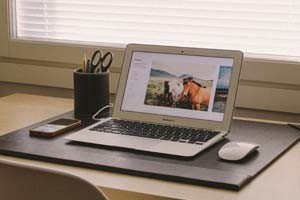5 Tips To Building The Best DIY Website Possible

Well, it was a nice dream while it lasted.
While hiring a professional to build your website is the ideal, I realize not every budget allows for that. So, what are your options? Doing business without a website these days is like riding a bicycle with a flat tire—it’s hard to get anywhere without wearing yourself out. That leaves building the site yourself.
Now, before you go cross-eyed from all of the YouTube DIY videos you’re about to watch, here’s some advice…
Image Size
While the bigger the image the better if we’re talking about getting a framed family portrait, this isn’t the case with websites. The most common desktop screen sizes are 1366 x 768 and 1024 x 768. These numbers are pixel dimensions, which means that instead of inches the size is measured by the number of dots of color. Since the largest, most common screen width is 1366 pixels wide, there’s really no earthly reason to have a blog photo any larger than that.
What’s it matter? Why not have a large, beautiful image anyway? Because it takes forever to load on someone else’s computer. Lots of pixels = large file size. When a visitor goes to your website, the first thing their browser does is download all the information needed to view the site. So, if they have to download 7 giant image files + all the other info your web page holds, odds are they’re going to navigate away from your site before it finishes loading.
P.S. If you want to know where to find the pixel dimensions of your photos, open up Finder (mac) or My Computer (pc), navigate to the image, and look at the details. Sometimes you may need to right click and “Get Info” or view the “Properties,” depending on how your system is set up. Also, for those of you with basic operating systems, Paint is a good program to resize those gigantor photos. Check it out on Google, or cue up another YouTube video for step by step instructions.
Optimize Those Images!
What’s this mean? Basically, it means getting your images to perform the best they can for you, which would include 1) looking good and 2) being small in file size. So once you have your photo sized down to an appropriate size (see above), you’ll want to run them through an image optimizer. Image Optimizers compress the files and make them smaller. There are many versions and options for this, but I personally use ImageOptim, which can be downloaded at https://imageoptim.com/. Nope, not getting paid for that link.
Use Alt Text
While you’re making those photos look good and perform well, take it a step further—make your images SEO-friendly and accessible for those who have screen readers. Whether you’re using Squarespace, WordPress, Wix, or any other website builder, there’s almost always a space for you to enter Alt Text (short for alternative text).
What is it? It’s for those screen readers I mentioned. People with disabilities who can’t see your beautiful images use software to read screens while browsing the internet. The screen reader will pick up that text and read it to the user. Basically, Alt Text is an embedded caption for your image. So if you’re uploading a picture of your dog, give it the Alt Text, “Fido, my dog.” It may seem silly or unnecessary, but screen readers are becoming more and more common, and Google now checks to see whether or not you’ve added those Alt Texts, which can alter your SEO ranking one way or another.
The Words
Yep, you need some of those on a website. The biggest and best way for Google to figure out who you are and what your website is about is through words. If you don’t have any words, Google probably doesn’t know much about you, and will therefore, rank you pretty low in search engine results. This means no one will ever find your site. So write something meaningful and slap it up there with your beautiful images!
For a smaller website, it’s best to have at least 300 – 500 words per page. That’s about 1 page of text in a Word Document. Sure it sounds like overkill, but it’s the best way for you to give your visitors valuable information that’s relevant to their search. If you’re not providing information on your website, Google assumes you’re not going to help out web viewers, and will therefore, not rank you.
Heading Tags
When you’re writing your awesome content on your site, you’re probably going to write it out in separate paragraphs, right? If you weren’t originally planning on this, go ahead and shake your head yes anyway. It’s important to separate information into digestible chunks.
Separating those paragraphs into sections, kind of like a newspaper, will help your reader skim (which they will do whether you want them to or not) and get the most information with the least amount of effort. Give each section a descriptive title, something that tells your readers what that particular section is about. And then—and this is the most important part—use the heading tags!!
Heading tags can be found in the text styling section of your website builder. It’s usually set on “Paragraph.” So type it all out, highlight your title, and select “Heading” from the dropdown menu.
Note: a webpage typically has one Heading 1 < h1 > tag as an overall encompassing “What this page is about.” It may have more than one Heading 2 < h2 > tag, and more than one of the rest. It’s a hierarchy thing; think of them like an outline, with Heading 1 being the biggest and most important, Heading 2 being the next most important, Heading 3 – the next, and so on.
To Sum It All Up
- Size images appropriately.
- Use Alt Text on your images.
- Write about 300-500 words per page for smaller websites.
- Use headings!
There will always be something that can be improved. There will always be a way to make your site more SEO-friendly. If you need some help, well, that’s what I do.
Bonus tip: For any website, professionally built or otherwise, it’s not a one-and-done situation. There are things like back-end maintenance that need to be done periodically. Also, Google is checking to see how often a site is updated. If a site hasn’t been updated in ages, then the ranking will drop. So, build that business and that budget, and then give me a call! I love working with small businesses!

 I know you’re tired of being the world’s best-kept secret. Shoot, you’re just tired in general.
I know you’re tired of being the world’s best-kept secret. Shoot, you’re just tired in general. When your website is already kicking butt, the best way to convert browsers into buyers is with a sales funnel.
When your website is already kicking butt, the best way to convert browsers into buyers is with a sales funnel.